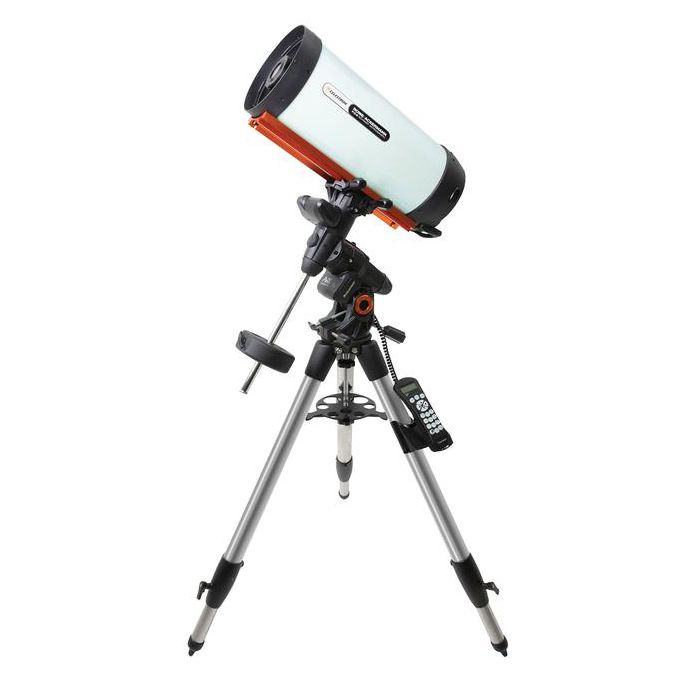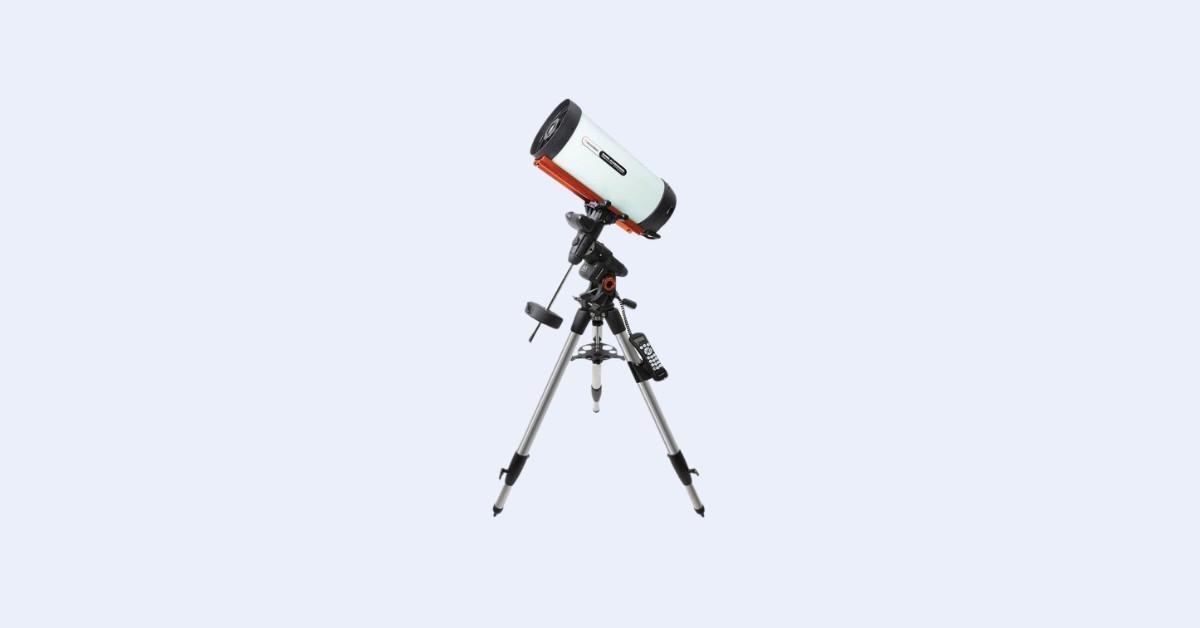The 8” RASA Optical Tube
The RASA design is based on the Schmidt Camera, which was invented in the 1930s by one-handed optician Bernhard Schmidt. The Schmidt camera has a primary mirror that is spherical and has a very fast focal ratio, usually between f/1.5 and f/2. A parabolic primary mirror would have too much coma (even with a coma corrector) to be used at such a speed and would be extremely difficult to manufacture. A spherical mirror has severe aberrations that make images fuzzy, getting worse at faster focal ratios, but is easy to manufacture and test. The Schmidt corrector is a thin piece of glass with a complex curve that can be easily mass-manufactured, which corrects spherical aberration and allows for a sharp image. The Schmidt corrector was placed at the radius of curvature of the mirror to achieve optimal correction without needing as strong a curvature. Putting a glass plate or film directly at the focal plane of the telescope, suspended in the middle like a secondary mirror, allowed for extremely wide fields of view at a super-fast focal ratio.

There’s just one problem: the Schmidt camera design produces a focal plane that is extremely curved. This was solved by bending film or glass plates to fit the focal plane. This was an annoying task, and even though commercial Schmidt cameras were offered by Celestron back in the 1970s, few amateurs bothered with those telescopes due to the nuisance of cutting individual film slices, bending them to fit the holder, and retrieving them. Aiming the telescope manually was also difficult. The Schmidt camera design languished for amateurs, though it was popular for professional telescopes until the arrival of digital camera sensors, which cannot be bent to accommodate a curved focal plane (a noticeable exception was the planet-hunting Kepler space telescope, which actually had a massive curved array of CCD detectors).
The arrival of the Starizona Fastar and HyperStar systems slowly began to revive the idea of Schmidt cameras by turning the already-available Celestron Schmidt-Cassegrain telescopes into ad-hoc Schmidt cameras, using lenses to compensate for spherical aberration not fully removed in the absence of the secondary mirror as well as to flatten the field. However, Fastar was not very good, and the HyperStar system has drawbacks such as vignetting and the risk of issues when removing the secondary mirror such as dust or damage because of its retrofitted nature.
The RASA design, created in-house by Celestron optical engineers, effectively takes a Celestron Schmidt-Cassegrain telescope and permanently removes the secondary mirror and visual back, putting the HyperStar inside the tube and allowing for better collimation, focus, and spacing tolerances, as well as a wider achievable field of view, lighter weight, and a simpler setup. Light simply enters the tube, is slightly bent by the Schmidt corrector, bounces off the spherical f/2 primary mirror, and is then corrected further by four rare earth element corrector lenses at the middle of the telescope. You attach your camera with an adapter to the M42 or C threads at the front of the Schmidt corrector.
One key aspect to keep in mind when considering a RASA is the need for frequent and precise collimation and very accurate focusing. An f/2 instrument requires a high level of accuracy in positioning the mirror and lens assembly due to its very shallow depth of field. Collimation is adjusted by tilting the center assembly, which your camera attaches to. Collimation is made more difficult by the fact that there is no center on the primary mirror to aim a laser at, nor can you just look through an eyepiece at a defocused star. Due to the shallow depth of field, you also need to be very precise with your focus. To use the 8″ RASA, you really need an electronic focuser and a Bahtinov mask.
The 8” RASA has vents with cooling fans at the back to help cool down, and focuses by moving the primary mirror back and forth on a rod inside the tube. Built-in hardware inside the tube ensures minimal “mirror flop” without having to engage locking knobs once you’ve reached focus.
To attach the 8” RASA to a mount like the Advanced VX, a CGE-style dovetail is attached, similar to a Losmandy D-style plate. On top, you can add a dovetail that lets you attach a guide scope, mini computer, or other astrophotography accessories. There’s a carry handle built into the back to assist in lifting it onto a mount, too.
Accessories
No eyepieces or other visual accessories come with the RASA 800, as it cannot be used with them. The Advanced VX RASA 800 package has no finder scope either, since you will have to aim the telescope by plate-solving anyway. All you get are some camera adapters and a battery pack for the cooling fans.
The Advanced VX Equatorial Mount
The Advanced VX mount is a budget GoTo equatorial mount Celestron offers with many telescopes. It has some limitations for deep-sky imaging, due to its cheap servo motors, poor declination axis bearing design, and the fact that you have to connect to the mount via a MicroUSB cable plugged into the hand controller rather than directly plugging the Advanced VX into a PC. The 8” RASA is at the limit of what the Advanced VX can handle for deep-sky imaging, and you will need autoguiding. You attach the 8” RASA optical tube with its CGE dovetail to the Advanced VX mount’s dual dovetail saddle, which fits Vixen and CGE-style dovetails, though it cannot fit Losmandy-style dovetail plates unless you purchase an aftermarket dovetail saddle designed to do so.
A single 11-pound counterweight is provided with the Advanced VX RASA 800 package, but most astrophotography setups will probably necessitate you purchasing another one. The Advanced VX’s advertised payload capacity is 30 lbs; most astrophotographers’ rule of thumb is to not exceed more than half the weight capacity of a mount. The 8” RASA is 17 lbs bare, which obviously violates this rule. However, the 400mm focal length of the 8” RASA is much more tolerant of tracking and guiding faults, allowing one to get away with using the Advanced VX without too much in the way of issues despite the mount’s flaws. You can read more about the Advanced VX and some of its downsides in our review of the Advanced VX mount.
Since you can’t look through the RASA, you’ll need to use Celestron’s CWPI software or something else that runs the ASCOM drivers to control the entire Advanced VX RASA 800 mount. The hand controller will serve as little more than an adapter. It is recommended you just run your camera and mount with software such as NINA or Sequence Generator Pro, which will drive the mount around and allow you to plate solve. Setting up the mount in this scenario consists of leveling the mount, attaching and balancing the telescope and accessories, and then polar aligning, after which you’ll power it up, get it aimed at something to focus, and then use your software to automatically slew roughly towards a target, plate solve until it is centered on what you want, and then image, autoguiding the mount with software such as PHD2 and a suitable guide scope/camera piggybacked on the RASA optical tube assembly.
Camera Limitations
Having to put a camera in front of the RASA immediately limits your options, since a big camera will block part of the aperture. This rules out a DSLR right away, as well as a huge CCD camera.
At the very least, your cables will get in the way of the 8″ RASA. This can cause optical artifacts in images, but if you line them up right, you can make diffraction spikes that look nice, like those in a Newtonian reflector.
The design of the RASA fundamentally limits camera choices further in its spacing requirements. Even if a filter wheel didn’t obstruct half the telescope, it would place the sensor too far from the front of the tube. This pretty much rules out monochrome cameras, unless you want to only shoot one color channel per night and switch filters by hand. Color CMOS cameras with large, cooled sensors are usually what is recommended for use with the RASA telescopes, though a regular mirrorless camera also works (albeit obstructing more of the aperture). The full illuminated field of the 8” RASA is 32mm diagonal, so there will be some vignetting with “full frame” 42mm sensors, albeit manageable with some cropping.
Should I buy a Used Celestron Advanced VX 800 RASA?
Given its complexity, we would recommend you only consider a used 8” RASA from someone who has actually used it or a reputable astronomy vendor.
Aftermarket Accessory Recommendations
Obviously, using the 8” RASA requires a cooled astronomical camera, guide scope and camera, and a Bahtinov mask for focusing. You’ll almost certainly need to put a second dovetail bar on top of the optical tube to attach your guiding setup, along with any dew controllers, cable routing, or even a mini PC, to the telescope. A dew shield to prevent condensation, avoid unwanted touching of the corrector plate, reduce glare, and route your cables through is a must. You may also want a dew heater. A motor focuser is highly recommended as well, such as those offered by Celestron, ZWO, and Pegasus. A PC, cables, and various other apparatus, like a power supply, will be required to control all this kit.
For polar aligning the Advanced VX, the Celestron polar scope or a PoleMaster device is required since you cannot realistically use All-Star Polar Align with the RASA or get good results with a rough alignment.
What can you see?
You can’t see anything with the 800 RASA because it can’t physically hold an eyepiece, and even if you could somehow attach an ocular, your head would block the aperture.
Astrophotography Capabilities
The 8″ RASA may be an 8″ telescope, but thanks to its 400mm focal length, it handles like a small, fast imaging refractor on steroids in terms of what you can shoot with it. The f/2 speed means you need far less exposure time for some of the brightest objects, like Orion or the Andromeda Galaxy, while you can shoot fainter objects that would be out of reach of a smaller telescope at 400mm focal length. You can go for some really interesting stuff with enough exposure time even if you don’t have the latest and greatest in camera technology, thanks to the 8” RASA’s sheer speed.
At 400mm focal length, this is a telescope for nebulae, open star clusters, and other wide-field targets. Globular clusters, galaxies, and other smaller objects are more appropriate for a longer focal length instrument like a Newtonian reflector astrograph, a Ritchey-Chretien, or an f/6-f/7 reduced Schmidt-Cassegrain telescope.



